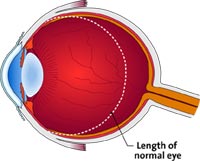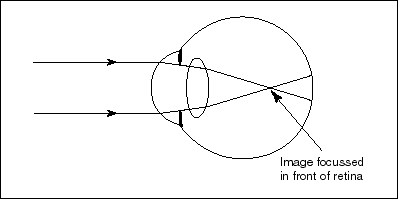


| This website exists not to sell you things, but to educate you. We do have several products for sale ONLY because the eye doctors refuse to make them available to you. To learn more, see Products. |
The abnormal elongation of the myopic eye. Our eyes were never designed by evolution for the way we use them today. In order for the eye to focus on close objects, the ciliary muscle tightens and causes the lens of the eye to thicken. Constant focusing on close objects causes a spasm of the ciliary muscle, a constant pulling on the sclera and a related pressure increase in the vitreous, or large chamber of the eye. As the sclera stretches and becomes larger, the body creates more liquid in the vitreous to fill the increased volume. This is the body's simple way of refining the vision by reducing the normal farsightedness of the infant. For a more technical description of this process, see Myopter Research Paper. This natural elongation of the eye becomes abnormal when the eye has no farsightedness left and moves into a myopic condition. The suspensory ligament which supports the lens, and the ciliary muscle (ciliary body) which surrounds the lens and controls its shape, can be seen in this diagram.



This dynamic lengthening of the eye was discovered by Francis A. Young, Ph.D., former Director of the Primate Research Center at Washington State University in Pullman, Washington, and this country's foremost myopia researcher with over 35 years of work in the field and more than 85 published research studies. A partial list of his published papers can be seen at Francis Young Papers.
He surgically placed a transmitter into the vitreous chamber of laboratory monkeys so that the pressure could be measured by electronic equipment located outside the animal's body. The vitreous pressure increased in proportion to the focusing effort (accommodation). The maximum increase was 6 mm of mercury above the normal 12 mm of mercury, in other words a 50% increase (Francis A. Young, "The Development and Control of Myopia in Human and Subhuman Primates," Contacto 19, no. 6, November, 1975).
From these and his many other studies on both humans and monkeys, Dr. Young concluded, "It appears quite clearly that myopia results from a continuous level of accommodation, and if one prevents this continuous level of accommodation from occurring, very little myopia, if any, should occur." (Francis A. Young, "The Development of Myopia," Contacto 15, no. 2, June, 1971).
The lengthening of the eye that results from this stretching allows reading to be done with less focusing effort and is the body's way of relieving the stress of prolonged close work. Unfortunately, the eye is capable of continuing this lengthening process until it literally tears itself apart! By this is meant that the longer the eye becomes, the more likely it is for the retina to detach from the underlying tissues. This detachment can happen gradually or spontaneously. X-rays have shown that myopic eyes are stretched as much as 25% longer than normal. Pictures of such eyes are to be found in standard textbooks. Usually, such detachment eventually leads to blindness. Any overelongation of the eye can increase the risk of retinal detachment in later years.
Think of this analogy. If you lift weights, the muscles become larger and stronger. Why? Why don't they just remain the same? The reason is that by becoming larger and stronger the work can be done with less stress on the body. The body does not like a constant condition of stress. The eye also does not want to operate under a constant condition of stress. It wants to be relaxed for distance, with the ciliary muscle contracting only for brief periods of close focusing. That is the goal of the visual feedback system, refining the length of the eye to attain maximum efficiency.
In this picture of a highly myopic eye, it is obvious how the stretching of the retina contributes to the danger of retinal detachment. In the group of people with more than 6 diopters of myopia, there is a 1 in 20 chance of a retinal detachment in their lifetime, as opposed to a 1 in 20,000 risk in the rest of the population.

Professor E. S. Perkins, a researcher with the department of ophthalmology at the University of Iowa Hospitals and Clinics wrote, in an article entitled "Morbidity from Myopia" for the spring, 1979 issue of the Sightsaving Review, that myopia was the 4th major cause of blindness, following senile macular degeneration, cataract and glaucoma. Myopia was the most common cause of blindness in age group 50-59. In age group 60-69, it was second only to diabetic retinopathy, but was considerably more important than that disease in terms of years of blindness.
How doctors destroy vision with minus lenses. The wearing of distance or minus power (concave) glasses aids the vision of myopes by bringing everything closer so that distant objects are within the range of focus. A book may still be held at arm's length but from a focusing standpoint it has now been moved closer to the eyes. This begins a vicious circle which soon results in the need for stronger glasses. Increasing amounts of effort are necessary to focus each time the power of the glasses is increased. Isn't it logical that this could cause the vision to get worse much faster than if no glasses were prescribed?
The first drawing below shows in an exaggerated fashion how distant rays come to a focus in front of the retina of a myopic eye. The second drawing shows how this problem is "corrected" by using a minus, or concave, lens.

Myopic eye

Corrected myopic eye
The corrected eye is now receiving diverging rays, created by the minus power lens, as if it were looking at something close. In fact, if you project those rays to the left until they meet, you will see where the eye "thinks" the object is. The distant object has been moved closer and the elongation of the eye continues.
Remember that no studies have ever been done that prove the safety of minus lenses. If such glasses were being invented today, it is unlikely they would be permitted on the market until their safety had been proven. In the opinion of many researchers, they will never be proven safe. The first use of minus lenses to correct myopia was by Johannes Kepler (1571-1639), a German scientist. Now, over 400 years later, they are still being misused to destroy vision.

The above picture shows someone wearing strong minus lenses. This man would be almost blind without those glasses. He didn't start out in life this way. It is the prescription of stronger and stronger glasses over the years, and using those glasses for close work, that has caused this irreversible damage.
For several hundred years, myopic people have been receiving treatment that is the exact opposite of what they should be getting. It is the old story of treating symptoms and ignoring causes that has always permeated the medical establishment.
The proper treatment for myopia is to use reading glasses for all close work. These are glasses with convex or "plus" lenses. By making the light rays less divergent, these glasses reduce the amount of accommodation required and lessen the likelihood of a ciliary spasm developing. If strong enough lenses are selected, all the accommodation can be eliminated and the eyes will be completely focused for distance. If a spasm is already present, it can be eliminated and the vision improved by as much as one diopter. The diagram below shows how this happens, using an emmetropic or normal eye as an example.

Reading Glasses
Suppose that the book is normally held at about a distance of one-third meter from the eyes, at B. Since a +3 D lens has a focal length of one-third meter, if it is placed in front of the eye it will make the diverging rays become parallel before entering the eye. The dotted lines show that the eye is receiving parallel rays as if from a distant object. Thus, this eye can read without accommodation. This is called reading at the far point.
Research proving the environmental cause of myopia. Some children are born with a high degree of myopia. This is a congenital birth defect. This can have many causes, such as drug use by the mother, and is not covered here. This site deals with acquired myopia, which is caused by an abnormal visual environment. Here is a sampling of research done in the USA during the past several decades that has provided evidence that this acquired myopia is not hereditary, but environmental.
1) Since the eyes of certain monkeys are nearly identical to human eyes, a hood was used to restrict the vision of such monkeys so that they could see no farther away than 15 inches (38 cm). It was found that most of them developed high myopia just as humans do (Francis A. Young, "The Development of Myopia," Contacto 15, no. 2, June, 1971). Monkeys living in the wild, however, do not develop myopia (Francis A. Young, "Visual Refractive Errors of Wild and Laboratory Monkeys," Eye, Ear, Nose and Throat Digest 27, August, 1965).
2) The vision of Eskimos living on the northern shore of Alaska was examined. It was found that the parents and grandparents, who were illiterate and living a typical outdoor life, were not myopic. Of the children, who had the benefit of compulsory education, fully 60% were myopic (Francis A. Young et al, "The Transmission of Refractive Errors within Eskimo Families," American Journal of Optometry and Archives of the American Academy of Optometry 46, no. 9, September, 1969). Primitive or illiterate people around the world generally do not develop myopia. How can this be explained by the heredity theory?
3) In a study entitled "Bifocal Control of Myopia," Kenneth H. Oakley and Francis A. Young described how they used bifocals on children to reduce their rate of myopia progression to a fraction of what it would have otherwise been. (American Journal of Optometry and Physiological Optics, 52, no. 11, November, 1975). For the full report, read Bifocal Control of Myopia.
4) Navy submarine personnel, working in a confined visual environment, develop myopia much faster than other personnel (Ira Schwartz and N. Elaine Sandberg, "The Effect of Time in Submarine Service on Vision," Medical Research Laboratory Report no. 253; Bureau of Medicine and Surgery, Navy Department project NM 003041.57.03).
5) In a study entitled "Accommodation, Refractive Error and Eye Growth in Chickens," and published in Vision Research., Vol 28, No. 5 pp 639-657, 1988, Pergamon Press, Frank Schaeffel, Adrian Glasser and Howard C. Howland found that:
6) In a study entitled "Bifocals May Slow Progression of Nearsightedness in Children," published in the January, 2010 issue of Archives of Ophthalmology, and reported in Science Daily on Jan. 12, 2010, further proof was found:
Recent statistics show that In the United States the prevalence of myopia for individuals aged 12 to 54 years was significantly higher in 1999 to 2004 than in 1971 to 1972 (41.6 percent vs. 25 percent, respectively).
The amount of acquired myopia in the Far East is much higher than in the USA. The large amount of study needed to master and use oriental characters is thought to be a contributing cause. For a summary of research on this topic, see Myopia Prevalence in Asia.
And a school in China has taken the lead in providing desks that keep the eyes of the children a safe distance from their work. This is an amazing revolution. Don't fail to read Anti-myopia School Desks.